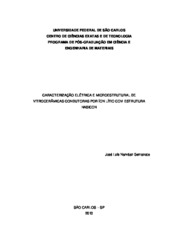| dc.contributor.author | Semanate, José Luis Narváez | |
| dc.date.accessioned | 2016-06-02T19:10:18Z | |
| dc.date.available | 2013-09-24 | |
| dc.date.available | 2016-06-02T19:10:18Z | |
| dc.date.issued | 2013-07-22 | |
| dc.identifier.citation | SEMANATE, José Luis Narváez. Electrical and microstructural characterization of lithium ion conductive glass-ceramics with NASICON structure. 2013. 193 f. Tese (Doutorado em Ciências Exatas e da Terra) - Universidade Federal de São Carlos, São Carlos, 2013. | por |
| dc.identifier.uri | https://repositorio.ufscar.br/handle/ufscar/711 | |
| dc.description.abstract | This doctoral thesis presents results of the chemical, thermal, structural, microstructural and electrical characterization of glass and glass-ceramics with Li1,3Al0,3Ti1,7(PO4)3 (LATP), Li1,5Al0,5Ge1,5(PO4)3 (LAGP) and (LixNa1-x)1,5Al0,5Ge1,5(PO4)3 (LNAGP) compositions. All the compositions are shown to present homogeneous volume nucleation (Tgr ≤ 0.6), enabling their microstructures to be controlled through heat treatments, which in this study were single and double. The highly conductive NASICON-type phase was obtained in all the studied compositions. Secondary phases were also observed, albeit with no deleterious effect on the total electrical conductivity. Electrical characterization by impedance spectroscopy, performed at various temperatures below ambient temperature, enabled the contributions of the grain and grain boundary on the total electrical conductivity to be separated. An analysis of the two glass-ceramics, LATP and LAGP, leads to the conclusion that, in both cases, the total electrical resistance of the samples, and hence, their total electrical conductivity, is dominated by the grain boundary. The LATP composition presented higher electrical conductivity at room temperature, but also lower glass forming ability (very low Kgl). A Rietveld refinement of the LATP samples obtained by single heat treatment revealed that the concentration of lithium ions in the unit cell increases as a function of the heat treatment temperature. The electrical conductivity results indicate a relationship between this property and the thickness and volume fraction of grain boundaries, since the latter decrease with heat treatment temperature (in TTS case) and increase with nucleation time (in the case of TTD). The LATP samples obtained by TTD exhibited higher electrical conductivity than those obtained by TTS at the same temperature; however, this effect was not observed in the LAGP samples. The electrical conductivity of the LNAGP samples showed a mixed alkali effect in both the glasses and the corresponding glass-ceramics. | eng |
| dc.description.sponsorship | Universidade Federal de Sao Carlos | |
| dc.format | application/pdf | por |
| dc.language | por | por |
| dc.publisher | Universidade Federal de São Carlos | por |
| dc.rights | Acesso Aberto | por |
| dc.subject | Materiais | por |
| dc.subject | Vitrocerâmica | por |
| dc.subject | Condutores iônicos | por |
| dc.subject | NASICON | por |
| dc.subject | Espectroscopia de impedância | por |
| dc.title | Caracterização elétrica e microestrutural de
vitrocerâmicas condutoras por íon lítio com estrutura
NASICON | por |
| dc.title.alternative | Electrical and microstructural characterization of lithium ion conductive glass-ceramics with NASICON structure | eng |
| dc.type | Tese | por |
| dc.contributor.advisor1 | Rodrigues, Ana Candida Martins | |
| dc.contributor.advisor1Lattes | http://lattes.cnpq.br/4499231813051400 | por |
| dc.description.resumo | Nessa tese de doutorado apresentam-se resultados de caracterização química, térmica, estrutural, microestrutural e elétrica de vidros e vitrocerâmicas de composição Li1,3Al0,3Ti1,7(PO4)3 (LATP), Li1,5Al0,5Ge1,5(PO4)3 (LAGP) e (LixNa1-x)1,5Al0,5Ge1,5(PO4)3 (LNAGP). Mostrou-se que as composições apresentam nucleação homogênea (Tgr ≤ 0,6), característica que torna possível o controle da microestrutura através de tratamentos térmicos, que no caso foram simples (TTS) e duplos (TTD). Foi obtida em todas as composições estudadas a fase altamente condutora com estrutura tipo NASICON. Fases secundárias também foram observadas, porém sem efeito deletério na condutividade elétrica total. A caracterização elétrica por espectroscopia de impedância, realizada em temperaturas abaixo da ambiente, permitiu separar as contribuições do grão e do contorno de grão à condutividade elétrica total. Analisando as vitrocerâmicas LATP e LAGP se conclui que, em ambos os casos, a resistência elétrica do contorno de grão é quem domina a resistência total das amostras e, portanto, a condutividade elétrica total. A composição LATP apresentou maior condutividade elétrica total à temperatura ambiente, mas também menor habilidade para formar vidro (Kgl muito baixo). Foi encontrado por refinamento Rietveld que, nas amostras LATP obtidas por TTS, a concentração de íons lítio na célula unitária aumenta com a temperatura de tratamento térmico. Resultados de condutividade elétrica mostram uma relação entre esta propriedade e a espessura e fração volumétrica de contornos de grão, pois estes diminuem com a temperatura de tratamento térmico (no caso de TTS) e aumentam com o tempo de nucleação (no caso de TTD). No caso do LATP, amostras obtidas por TTD, tiveram condutividade maior do que as obtidas por TTS na mesma temperatura, porém esse efeito não foi observado nas amostras LAGP. A condutividade elétrica das amostras LNAGP mostra um efeito de alcalino misto tanto nos vidros como nas correspondentes vitrocerâmicas. | por |
| dc.publisher.country | BR | por |
| dc.publisher.initials | UFSCar | por |
| dc.publisher.program | Programa de Pós-Graduação em Ciência e Engenharia de Materiais - PPGCEM | por |
| dc.subject.cnpq | ENGENHARIAS::ENGENHARIA DE MATERIAIS E METALURGICA | por |
| dc.contributor.authorlattes | http://lattes.cnpq.br/9824558997496023 | por |
